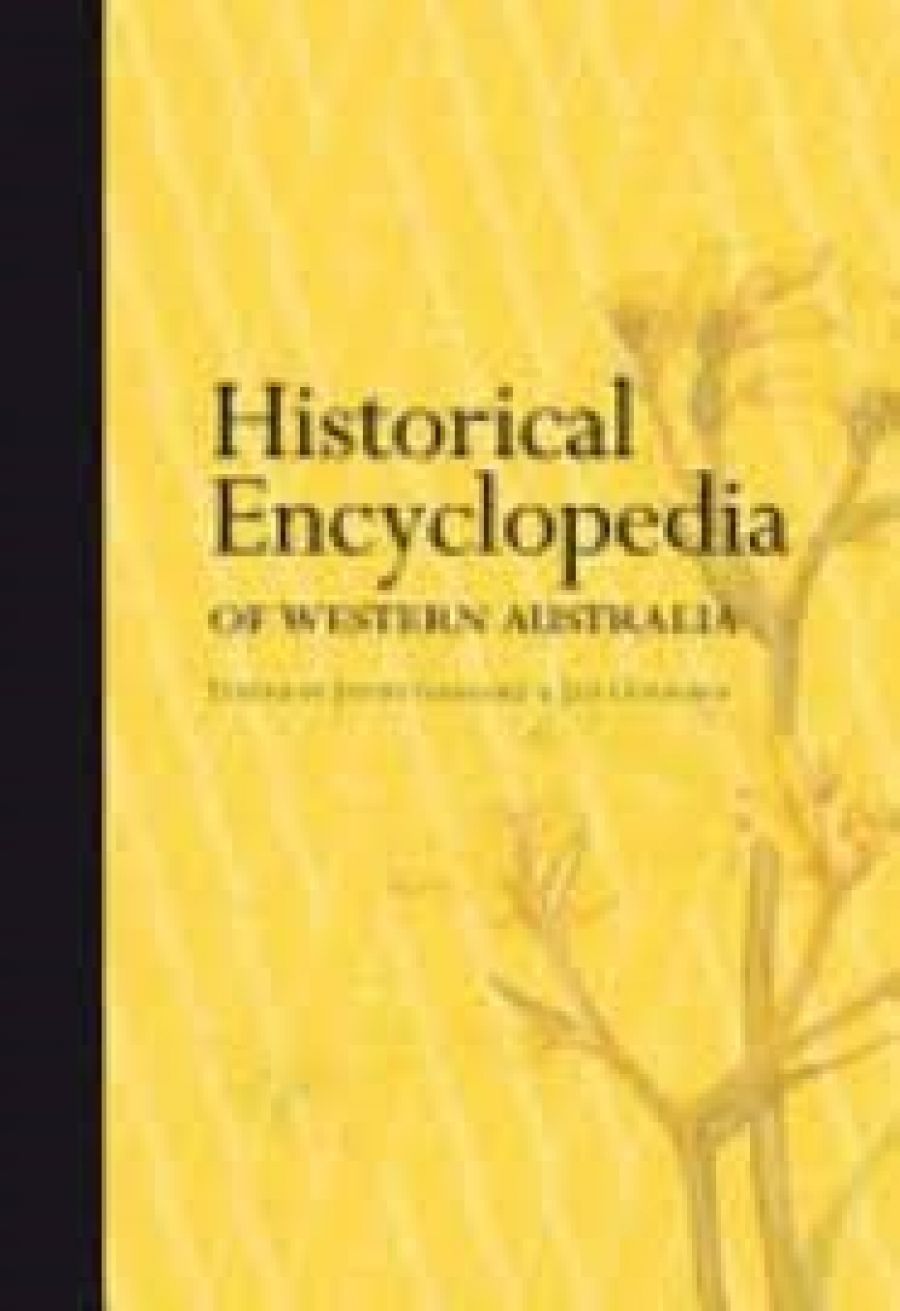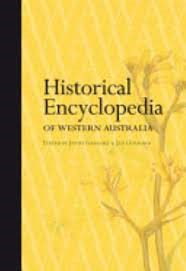
- Free Article: No
- Contents Category: Western Australia
- Review Article: Yes
- Article Title: A to Z of the West
- Article Subtitle: The new reference to Western Australia
- Online Only: No
- Custom Highlight Text:
In the closing years of the twentieth century, historians combined to produce large reference volumes of national history. Some were stimulated by anniversaries, notably the dictionary, atlas, gazetteer and chronology, guide to sources and compilation of statistics that were published by Fairfax, Syme and Weldon for the Bicentenary. Some were initiated by publishers, such as the Companion to Australian History (1998) that Graeme Davison, John Hirst, and I edited for Oxford University Press.
- Book 1 Title: Historical Encyclopedia of Western Australia
- Book 1 Biblio: University of Western Australia Press, $99.95 hb, 1044 pp
- Book 1 Cover Small (400 x 600):

These are large enterprises requiring substantial institutional support and sponsorship (the Historical Encyclopedia of Western Australia lists nine government agencies and four other partners), large teams of advisers (there were twelve on the editorial board of this one, while ninety historians participated in a planning workshop) and a host of writers (the six hundred who contributed to this volume outnumber the country’s academic history profession).
The logistics of the enterprise are daunting. Anyone who has edited a volume of essays will appreciate the difficulties in identifying the best contributors, cajoling their participation and then rounding up copy. It is more difficult to call in favours for a task of such magnitude, especially as contributions to reference works go unrecognised in the Australian higher education system’s rewards for publication. In practice, collegiality generally outweighs such base calculations and remarkably few requests are declined.
First, however, it is necessary to decide what the entries should be. The process is deceptively obvious: on the principle that purpose should determine design, you identify the intended readership and anticipate the information that will meet its needs. In practice, however, the cutting up of historical knowledge into self-contained components turns out to be a major exercise. The taxonomy has to be comprehensive and systematic. Some entries will be brief and spare, others longer and more interpretative, but the alphabetical arrangement forces consideration of the appropriate headword for these longer contributions. The Oxford and Wakefield companions provided a subject guide, the Tasmanian companion and the Melbourne encyclopedia a full index; this volume relies solely on cross-entries.
It follows the earlier volumes in generating entries from initial themes: geography, economy, politics, religion, society. These in turn yield sub-themes of varying elasticity. There are entries for all the regions of Western Australia, all the principal towns and some of the townships. Migration and multiculturalism are treated, and so too Croatians, Dutch, English, Germans, Greeks, Irish, Italians, Jews, New Zealanders, Poles, Russians, Scots, South Africans and Welsh; but other ethnic groups are incorporated into omnibus entries on Eastern-Central Europe, South-Eastern Europe and Asia. We thus have an entry for the Chinese New Year but not for the Chinese community. Yet more than thirty forms of sport are covered, and a full list of Sandover and Olympic medallists is appended.
On the other hand, you will look in vain for an entry on Graham Farmer or Shirley Strickland. After much discussion, the editors decided not to include biographical entries on the grounds that the Australian Dictionary of Biography (ADB) already ‘provides an outstanding reference for biographical information’. They are not the first to make this decision. The Encyclopedia of Melbourne did so too, while the Wakefield Companion contented itself with brief outlines of the South Australians who appear in the ADB and a fuller treatment of ‘outstanding high achievers’.
The ADB is an ornament of scholarship, and available online as well as in book form, but the exclusion of biography from a reference work surely negates its purpose. The reader encounters Kim Beazley Sr in the entry on Moral Re-Armament, is told that it motivated him to put Aboriginal land rights onto the ALP’s federal platform, and wishes to learn more about Beazley’s political career. If she combs the volume and finds the entry on federal politicians, she will learn that he won the seat of Fremantle in a by-election following John Curtin’s death in 1945, and by 1975 was the only Labor member of the House of Representatives from the West, but nothing more.
If we are told in the entry on the Forrest River Massacre that the Reverend E.R.B. Gribble reported the murder of Aboriginal people to A.O. Neville, the Chief Protector, we might want to know more about these two controversial figures. We could head for the nearest set of the ADB or go online to satisfy our curiosity, but we are holding a reference book and should be able to use it. Besides, a biographical entry in a book on Western Australian history is likely to give us local detail missing in a dictionary of national biography.
That flavour of Western Australia comes across in a host of entries. The one for Rajneesh told me more about the Orange People who flourished in Fremantle than I could ascertain when I lived there in the late 1970s. They were one of the exotic species that flourished in the absence of natural predators after crossing the Nullarbor. The entry on exotic fauna picks up species such as rabbits and foxes.
Brian de Garis’s brief entry on the Cinderella state helped me to understand the historical basis of that common designation; Charlie Fox’s long one on class draws out its distinctive subtleties in the West. Graham Seal’s treatment of folklore picks up some expressive terms in the Western Australian lexicon: ‘polony’ for what the South Australians call ‘fritz’, a ‘ging’ for a ‘shanghai’, and diminutives such as ‘Freo’ and ‘Subi’. But what about ‘Ding’? The Australian National Dictionary records some eastern-states usage of this derogatory term for an Italian, but it had widest currency in the West. Hence the affray at Kalgoorlie in 1934, which is related in the entry on race riots, was known as the ‘Battle of Dingbat Flat’.
A host of entries take up distinctive aspects of Western Australian history: camels, Dutch maritime exploration, Fenians, Fremantle Doctor, Indian Ocean, Jarrah dieback, pearling, rabbit-proof fence, Sandgroper, WA Inc., wheatbelt. Others take a more generic subject and explore its distinctive forms: economy, entrepreneurs (but if Claude de Bernales, why not Alan Bond?), manufacturing, mining and retailing; railways, rivers and roads; fiction, journalism, music, radio and theatre; politics, feminist movement, trade unions, and so on. Then there are organisations such as the Karrakatta and Weld clubs that are local instances of a more general phenomenon, or unique to the West, such the Ugly Men’s Association. Each of the universities is given an entry, though the one for Curtin reads as if it was lifted from promotional material.
More problematic are the entries on topics where the local content is incidental. The contributors on adolescence, alternative medicine, anti-smoking campaign, competition policy, conscription, domestic work, Korean war, Malayan campaign, migrant education and wartime propaganda struggle to find anything to characterise their Western Australian manifestations. At best they can provide some state statistics or name a local notable, but in the absence of biographies, the trail ends there.
Any reference work of this kind is drawn by a remorseless logic of ‘if X, then surely Y’, but I have a feeling that the net has been cast too wide. The purpose of the Encyclopedia, as explained in the introduction, is to ‘reshape the way we understand history in Western Australia’. To this end, it seeks to be truly encyclopedic, with entries on astronautics and zoology, acclimatisation and water management, to stand alongside ‘more traditional subjects’ such as foundation and royal tours, though the appendices also include a full list of them. Many of these entries are written by specialists on the subject with varying degrees of success. The best of them are informed and informative; others suffer from a lack of the historian’s awareness of context and contingency.
Alongside this principle that ‘everything is susceptible to historical analysis’ is an insistence on multiple voices and multiple perspectives. This is served partly by the commissioning of multiple entries (there are seven on music, with a good deal of overlap, and no less than three on cadets), partly by an emphasis on race, ethnicity, gender and class. The Aboriginal voice is certainly included: the first twenty-five entries begin with the prefix Aboriginal, despite one of the contributors protesting against the use of this portmanteau term.
The Historical Encyclopedia of Western Australia is thus a reference work and something more. It has the qualities of a good reference tool – comprehensiveness, clarity, close attention to detail – and the editors have clearly worked with their support staff to maintain consistency. It is also an exercise in exploration of a particular place and its people. The editors declare that ‘Western Australian history, once considered peripheral, is gradually being recognised for the way it enriches Australian history and contemporary understandings of the past’. I think the result vindicates the claim.


Comments powered by CComment